
0264-48-1208
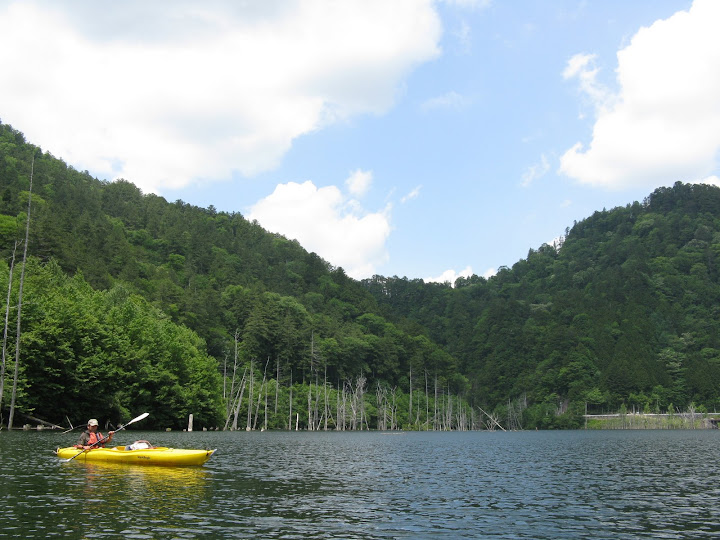 Some landscapes lend themselves to the aloof gazing of observers. For example, California's Yosemite Valley with its enormous walls of granite, or Japan's Kamikochi, which offers sweeping views of some of the Hida Range's finest alpine cirques, come to mind. Otaki's Shizen-ko 自然湖, meaning "natural lake", is not such a landscape. Rather, its beauty and grandeur come only from patient exploration and observation. The lake invites intimacy and refuses to welcome those who are unwilling to engage it, both physically and mentally. There is no overlook; no viewing from afar. In fact, much of Shizen-ko is hidden behind bends of trees or within vertical canyon walls. The landscape is, therefore, defiant of the insouciant looks of passers-by. In order to gain any sense of it, one must enter the lake and sit directly upon its waters. A kayak (called カヌー, pronounced ka nu-, in Japanese, a phonetic translation of the word "canoe") is a tool well suited to such an undertaking; it allows one to interact with Shizen-ko in a way that is deeper, and more equitable, than a gaze ever is. Ontake Adventure (おんたけアドベンチャー) of Otaki, runs kayak tours on Shizen-ko that offer this kind of deep experience-something rare in the Japanese tourist landscape of today.
Some landscapes lend themselves to the aloof gazing of observers. For example, California's Yosemite Valley with its enormous walls of granite, or Japan's Kamikochi, which offers sweeping views of some of the Hida Range's finest alpine cirques, come to mind. Otaki's Shizen-ko 自然湖, meaning "natural lake", is not such a landscape. Rather, its beauty and grandeur come only from patient exploration and observation. The lake invites intimacy and refuses to welcome those who are unwilling to engage it, both physically and mentally. There is no overlook; no viewing from afar. In fact, much of Shizen-ko is hidden behind bends of trees or within vertical canyon walls. The landscape is, therefore, defiant of the insouciant looks of passers-by. In order to gain any sense of it, one must enter the lake and sit directly upon its waters. A kayak (called カヌー, pronounced ka nu-, in Japanese, a phonetic translation of the word "canoe") is a tool well suited to such an undertaking; it allows one to interact with Shizen-ko in a way that is deeper, and more equitable, than a gaze ever is. Ontake Adventure (おんたけアドベンチャー) of Otaki, runs kayak tours on Shizen-ko that offer this kind of deep experience-something rare in the Japanese tourist landscape of today.
N-san, a young "I-turn" (which is a term referring to rural transplants from the city . . . and of course doesn't denote a "turn" at all), is in his fifth year of conducting kayak tours on Shizen-ko. He had agreed to give Aki and me a tour of the lake, and so on a clear and cool Monday morning we made our way to Shizen-ko along the Otaki River, enjoying the mosaic tapestry of bright greens that comprised the forests lining the road on either side. N-san, a steadfast man with a passion for his work and a dedication to the Shizen-ko landscape, was waiting us, having made all the preparations. When we arrived the waters of Shizen-ko were dancing and shimmering in the morning light, while casting up reflections of the world around. Kayaks lay in wait on the shore, their brilliant red color defying the green of the hillsides around them. N-san greeted us, "ohayou". His partner, K-san, also greeted us and took our bags for safe-keeping. A soft, cool wind was blowing off the lake, and because our hosts had taken care of everything Aki and I were free to simply take in the scene, which affected a welcome calmness within us both.
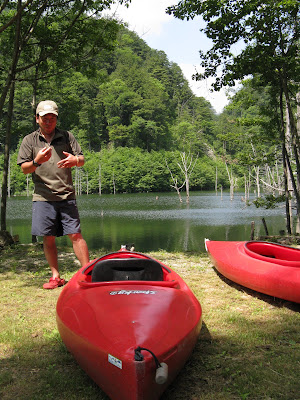 We geared up and stood next to the kayaks overlooking Shizen-ko. N-san stood with his back to the lake and began to tell us a bit about its creation, history, and current condition. Shizen-ko began its existence on the morning of September 14th, 1984 when a magnitude 6.8 earthquake struck Otaki and dislodged an enormous slab of Mt. Ontake's south-eastern slope, which then tore its way to the valley bottom at an incredible speed. Earth from the landslide covered a portion of the Otaki River, forming a natural dam that obstructed the flow of water. Shizen-ko was born. The lake began to take shape as rising waters filled the steep valley above the landslide. The trees, rocks, and everything else that had once comprised the landscape of the valley bottom were consumed by the rising waters. N-san didn't take too much time for his initial explanation, believing that the only way to get to know Shizen-ko is to spend time exploring it.
We geared up and stood next to the kayaks overlooking Shizen-ko. N-san stood with his back to the lake and began to tell us a bit about its creation, history, and current condition. Shizen-ko began its existence on the morning of September 14th, 1984 when a magnitude 6.8 earthquake struck Otaki and dislodged an enormous slab of Mt. Ontake's south-eastern slope, which then tore its way to the valley bottom at an incredible speed. Earth from the landslide covered a portion of the Otaki River, forming a natural dam that obstructed the flow of water. Shizen-ko was born. The lake began to take shape as rising waters filled the steep valley above the landslide. The trees, rocks, and everything else that had once comprised the landscape of the valley bottom were consumed by the rising waters. N-san didn't take too much time for his initial explanation, believing that the only way to get to know Shizen-ko is to spend time exploring it. Without delay, N-san passed Aki and me paddles and began explaining the basics of maneuvering our kayaks on the lake. The kayaks are extremely steady, so there is little chance of taking a swim, but N-san makes sure his guests know that this is totally their responsibility, and so accordingly instructs them diligently on how to use their kayak properly. He is marvelous as a guide in this respect; he is there to guide, but not to lead. I gained from N-san that he expects and hopes that guests will take the initiative to explore the lake for themselves--he is there to offer support and an in-depth knowledge to help with the journey. He's not, however, going to lead his guests there--the journey is theirs.
Without delay, N-san passed Aki and me paddles and began explaining the basics of maneuvering our kayaks on the lake. The kayaks are extremely steady, so there is little chance of taking a swim, but N-san makes sure his guests know that this is totally their responsibility, and so accordingly instructs them diligently on how to use their kayak properly. He is marvelous as a guide in this respect; he is there to guide, but not to lead. I gained from N-san that he expects and hopes that guests will take the initiative to explore the lake for themselves--he is there to offer support and an in-depth knowledge to help with the journey. He's not, however, going to lead his guests there--the journey is theirs.After N-san's brief introduction to the lake and the kayaks it was time to get on the water. For a first timer, like my wife, stepping into the kayak can be a bit nerve-racking, but ther
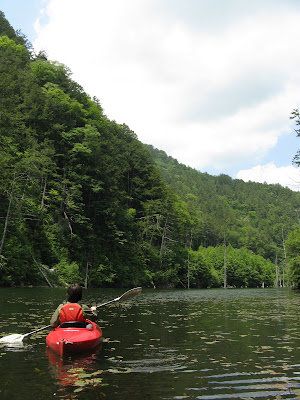 e is nothing to be afraid of, the kayaks are quite stable. With small pushes from N-san Aki and I were out on the lake in no time, with N-san and K-san right behind us. It's difficult to put into words the feeling of first gliding out onto the lake. One's center of gravity is low, down close to the water's surface, and so the world feels as if it is opening vertically above and below you. Instead of the apodictic feeling of terra firma beneath your feet, the sensation is one of disembodiment--your body and mind are free to drift where they will within the floating world. Of course the action of paddling brings you back into your body, but there's little need for strenuous effort; Shizen-ko is placid and so you are able to move smoothly through its waters with little effort, like strokes of a calligraphy brush.
e is nothing to be afraid of, the kayaks are quite stable. With small pushes from N-san Aki and I were out on the lake in no time, with N-san and K-san right behind us. It's difficult to put into words the feeling of first gliding out onto the lake. One's center of gravity is low, down close to the water's surface, and so the world feels as if it is opening vertically above and below you. Instead of the apodictic feeling of terra firma beneath your feet, the sensation is one of disembodiment--your body and mind are free to drift where they will within the floating world. Of course the action of paddling brings you back into your body, but there's little need for strenuous effort; Shizen-ko is placid and so you are able to move smoothly through its waters with little effort, like strokes of a calligraphy brush.Due to the nature of its violent birth, Shizen-ko exists now as a newer, and rapidly developing, ecosystem nested in a much older, established one. On the near shore of the lake is a young forest comprised mostly of fast-growing broadleaf varieties, while on the far side there stands a much more mature mixed forest where cypress and cedar trees tower majestically above a lower story of deciduous trees and a variety of shrubs. The younger forest sprouts from the flow of dirt and debris left after the
 earthquake and so one finds mixed in with the trees twisted strands of metal from a guard rail that had once lined a road traversing the upper part of the valley through which the Otaki River had flowed (and still flows, beyond Shizen-ko). There's also a tunnel that sits adjacent to the lake, slowly being consumed by the forest. A hot spring inn that sat in a canyon leading up the face of Ontake-san was also washed away in the landslide; the bodies of several individuals, therefore, also remain forever a part of the landscape, buried somewhere in the debris. In this respect, the Shizen-ko landscape is at once shocking and violent, but also wondrous, and above all . . . peaceful. N-san understands the multi-faceted nature of Shizen-ko; he respects this nature and tries to impart it to his guests.
earthquake and so one finds mixed in with the trees twisted strands of metal from a guard rail that had once lined a road traversing the upper part of the valley through which the Otaki River had flowed (and still flows, beyond Shizen-ko). There's also a tunnel that sits adjacent to the lake, slowly being consumed by the forest. A hot spring inn that sat in a canyon leading up the face of Ontake-san was also washed away in the landslide; the bodies of several individuals, therefore, also remain forever a part of the landscape, buried somewhere in the debris. In this respect, the Shizen-ko landscape is at once shocking and violent, but also wondrous, and above all . . . peaceful. N-san understands the multi-faceted nature of Shizen-ko; he respects this nature and tries to impart it to his guests.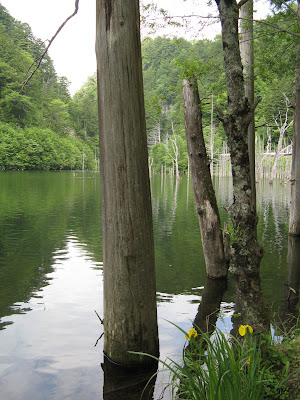 Shizen-ko's aquatic ecosystem is also evolving. During his five year relationship with the lake N-san has observed this evolution diligently and he therefore holds a subtly crafted knowledge of it. When I ask about a water plant occupying considerable portions of the lake's southern end, he tells me that the plant is known as hiru-mushiro 蛭莚 (Potamogeton distinctus) and is a perennial that grows well in stagnant waters. He surmises that the plant will continue to thrive and occupy more of the Shizen-ko ecosystem, helping to create habitat for fish. I'm impressed with N-san's analysis; those with a shallower understanding of the lake's ecology might try to eradicate the seemingly noxious weed.
Shizen-ko's aquatic ecosystem is also evolving. During his five year relationship with the lake N-san has observed this evolution diligently and he therefore holds a subtly crafted knowledge of it. When I ask about a water plant occupying considerable portions of the lake's southern end, he tells me that the plant is known as hiru-mushiro 蛭莚 (Potamogeton distinctus) and is a perennial that grows well in stagnant waters. He surmises that the plant will continue to thrive and occupy more of the Shizen-ko ecosystem, helping to create habitat for fish. I'm impressed with N-san's analysis; those with a shallower understanding of the lake's ecology might try to eradicate the seemingly noxious weed.N-san gave an account of all these various aspects of the lake-not in an overt way, but simply as things came into view or as questions arose. Again, this is the strong point of Ontake Adventure kayak tours of Shizen-ko; N-san understands the value of the lake's silence, as well as the importance of personal exploration and interaction on the part of his guests. He respects these things and tries to protect and encourage them--explanations come only when questions come floating, like fallen leaves, along the water's surface.
Having reached the southern tip, we turned our kayaks around and headed back towards the dock in the lake's mid-section. I steered my way to the far side of the lake, where older trees stand and gazed up, admiring the gentle movements of their swaying. Next, I maneuvered close to a group of tree stumps poking out from the lake just beyond the shoreline. N-san had explained to me that before the earthquake these trees sat high on the valley wall, overlooking the Otaki River. As the waters of Shizen-ko began to rise the trees were cut for timber. He also suggested that the trees which remain under the water may some day be harvested because their cores have not been penetrated by water and remain viable as timber. In my mind I recreated the landscape before the earthquake: drained the waters, pulled the vegetation a bit further down the hillside, and replaced the ghost trees upon the stumps before me.
When I caught up with the others in the middle of the lake N-san was tellin
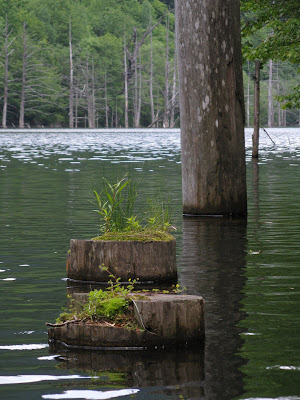 g Aki about two small islands, which are actually clumps of fallen trees supporting small-scale biotic communities. Moss, plants, and even young pine trees stand on the horizontal trees, like participants in a log rolling contest. This image, I learn, isn't far off; N-san recounted how in past years the fallen trees have become top heavy and spun in the water, forcing the vegetation standing upon them to twist and contort in an attempt to keep their "heads" above water.
g Aki about two small islands, which are actually clumps of fallen trees supporting small-scale biotic communities. Moss, plants, and even young pine trees stand on the horizontal trees, like participants in a log rolling contest. This image, I learn, isn't far off; N-san recounted how in past years the fallen trees have become top heavy and spun in the water, forcing the vegetation standing upon them to twist and contort in an attempt to keep their "heads" above water.We continued on, paddling our kayaks under a bridge, once part of the main road running to the center of the village, but now used only to get from the new road to the small piece of shoreline where N-san runs his tours from. Just beyond the bridge we landed our kayaks on the dry river bed of shimo-kuro-zawa 下黒沢, one of Otaki's many small streams. From a basket, K-san pulled water to drink and small treats made of acorn flour and sweet red bean paste to eat. The water was straight from a nearby spring that is fed by groundwater flowing underneath the earth of Ontake-san; it's cool and clean with a hint of sweetness that comes only with fresh spring water. As we drank and ate our snacks we could hear the calls of Japanese white-eye coming from the bushes nearby. The calls started as low warbles that eddied near the ground and then sprung up into the air in final high-pitched crescendos.
 N-san tells me that there is a waterfall he wants to show me later. He says that we can hear the waterfall from where we sit; we stopped talking and tuned our ears until we could hear the soft rumbling of water pounding rock. I'm a bit perplexed, because judging by the sound of the waterfall it doesn't appear to be too far away, and so there should be a steady flow of water entering the lake right where we sit. N-san explained that just below the waterfall is a shu-sui 取水 station. The characters 取水 mean literally "take" and "water". I had known prior to this time that a large tunnel runs through the mountains above Otaki, and that the tunnel was dug prior to WWII using forced laborers from China and Korea. I also knew that tunnel is used even know for transporting water to a power station where it turns turbines in order to generate electricity. This electricity is then transferred for use in the greater Osaka metropolitan area. The enormous tunnel (apparently, for maintenance purposes, a small truck can be lowered into and driven inside the tunnel) intersects all of the major streams flowing on the north side of the Otaki Valley. One of the aforementioned shu-sui stations is located at each of these intersections in order to divert water into the tunnel. The project is operated by Kansai Denryoku 関西電力, one of a two large power consortiums operating in Otaki. "Why don't Otaki's residents have rights of access to the water flowing in their village", I wondered to myself, gazing, a bit sternly, at the dry streambed. N-san said that he had wanted to tell me about this for some time. I sensed that he understands and cares deeply about this and other projects in Otaki and elsewhere in Japan-their lack of logic, equality, and justice. Truly, Otaki is a political ecology.
N-san tells me that there is a waterfall he wants to show me later. He says that we can hear the waterfall from where we sit; we stopped talking and tuned our ears until we could hear the soft rumbling of water pounding rock. I'm a bit perplexed, because judging by the sound of the waterfall it doesn't appear to be too far away, and so there should be a steady flow of water entering the lake right where we sit. N-san explained that just below the waterfall is a shu-sui 取水 station. The characters 取水 mean literally "take" and "water". I had known prior to this time that a large tunnel runs through the mountains above Otaki, and that the tunnel was dug prior to WWII using forced laborers from China and Korea. I also knew that tunnel is used even know for transporting water to a power station where it turns turbines in order to generate electricity. This electricity is then transferred for use in the greater Osaka metropolitan area. The enormous tunnel (apparently, for maintenance purposes, a small truck can be lowered into and driven inside the tunnel) intersects all of the major streams flowing on the north side of the Otaki Valley. One of the aforementioned shu-sui stations is located at each of these intersections in order to divert water into the tunnel. The project is operated by Kansai Denryoku 関西電力, one of a two large power consortiums operating in Otaki. "Why don't Otaki's residents have rights of access to the water flowing in their village", I wondered to myself, gazing, a bit sternly, at the dry streambed. N-san said that he had wanted to tell me about this for some time. I sensed that he understands and cares deeply about this and other projects in Otaki and elsewhere in Japan-their lack of logic, equality, and justice. Truly, Otaki is a political ecology.Our thirst quenched and hunger appeased we pushed off from the rocks and headed out, westward,
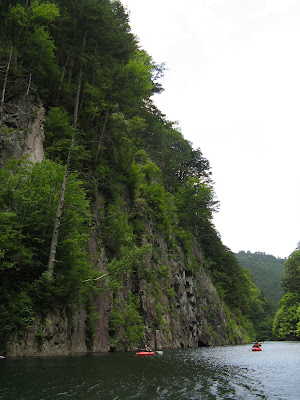 up valley and into a narrow canyon with a steep earthen slope on the south side and a vertical wall of rock on the north. N-san explained that prior to the earthquake a sacred waterfall with healing waters had flowed in this canyon. The Chinese character 王, pronounced "ou" and denoting royalty, he continued, is not often associated with place names in Japan. The village of Otaki 王滝 (written with the 王 character, and 滝 taki meaning "waterfall") is exceptional in this regard. As we drifted our kayaks over the now silent waterfall N-san recounted a local story that tells of the daughter of a royal family in Kyoto who fell ill and was near death. Her parents were powerless to help their daughter, until one night a waterfall appeared to the mother in a dream. The waterfall was located in a deep valley near the base of the holy mountain Ontake-san. The family dispatched a servant to bring water from the falls, which was given to the daughter. After imbibing this water the daughter soon recovered from her illness. Obliged because of the miraculous recovery the grateful family bestowed upon the waterfall the character "王"-making it 王滝, ou-taki, romanized as Otaki. This name was later adopted by the village of Otaki.
up valley and into a narrow canyon with a steep earthen slope on the south side and a vertical wall of rock on the north. N-san explained that prior to the earthquake a sacred waterfall with healing waters had flowed in this canyon. The Chinese character 王, pronounced "ou" and denoting royalty, he continued, is not often associated with place names in Japan. The village of Otaki 王滝 (written with the 王 character, and 滝 taki meaning "waterfall") is exceptional in this regard. As we drifted our kayaks over the now silent waterfall N-san recounted a local story that tells of the daughter of a royal family in Kyoto who fell ill and was near death. Her parents were powerless to help their daughter, until one night a waterfall appeared to the mother in a dream. The waterfall was located in a deep valley near the base of the holy mountain Ontake-san. The family dispatched a servant to bring water from the falls, which was given to the daughter. After imbibing this water the daughter soon recovered from her illness. Obliged because of the miraculous recovery the grateful family bestowed upon the waterfall the character "王"-making it 王滝, ou-taki, romanized as Otaki. This name was later adopted by the village of Otaki.Apparently, in the past the geography of this canyon made it a difficult area to
 traverse. N-san suggests that it is for this reason that Otaki's most remote hamlet, Takigoshi (which is said to have been settled by a defeated samurai clan in hiding), got its name. The characters for Takigoshi, 滝越, mean "waterfall" and "cross"--one had to get past, or cross, the waterfall "Otaki" to reach Takigoshi. The water in this part of the lake exuded a brilliant, almost florescent, green color, and although it was somewhat opaque, I could make out the jagged rock formations that had previously formed the crest of Otaki Waterfall. Looking closer I began to notice tonal changes in the water's color that denoted, like a topographic map, the vertical drop of the waterfall. I could imagine the canyon as it had existed before the waters of Shizen-ko consumed it, with jagged rock walls, falling water pounding the rocks below, and a swift flowing river. I shook from my head thoughts of what once was and looked around, imbibing the landscape around me as it was. The sun was straight overhead now, setting down forceful rays that illuminated the bodies of yellow wagtails that flew from upstream, tracing perfect arcs in the air with flicks of their quill-like tails.
traverse. N-san suggests that it is for this reason that Otaki's most remote hamlet, Takigoshi (which is said to have been settled by a defeated samurai clan in hiding), got its name. The characters for Takigoshi, 滝越, mean "waterfall" and "cross"--one had to get past, or cross, the waterfall "Otaki" to reach Takigoshi. The water in this part of the lake exuded a brilliant, almost florescent, green color, and although it was somewhat opaque, I could make out the jagged rock formations that had previously formed the crest of Otaki Waterfall. Looking closer I began to notice tonal changes in the water's color that denoted, like a topographic map, the vertical drop of the waterfall. I could imagine the canyon as it had existed before the waters of Shizen-ko consumed it, with jagged rock walls, falling water pounding the rocks below, and a swift flowing river. I shook from my head thoughts of what once was and looked around, imbibing the landscape around me as it was. The sun was straight overhead now, setting down forceful rays that illuminated the bodies of yellow wagtails that flew from upstream, tracing perfect arcs in the air with flicks of their quill-like tails.A
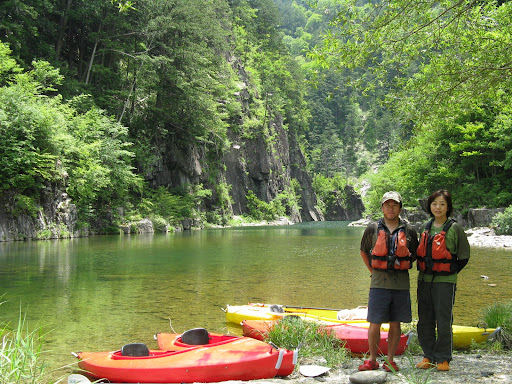 bit further on the river became shallow and I could see clear to the bottom where the rays of sunlight spun on upon smoothed stones. At this spot the flow of the river was split into two channels. A third channel was located in the middle of the river, but no water flowed here. I was not sure why (another water diversion station?). N-san informed us that the headwaters of Shizen-ko lay just up ahead. There's actually a dam located there--one of several in village. This particular one is named "Otaki Dam" after the waterfall, or perhaps the village, either way it's too good a name for a damn dam. We stopped and rested on a patch of sand spreading out fan-like from the dry river bed. The clear waters of the lake (or river? it was hard to judge here) tempted me with a swim, but the day was cool enough to dissuade me. I was content to remain where I was, looking out over the water and up at the rich blue sky where clouds billowed like fresh milk in tea.
bit further on the river became shallow and I could see clear to the bottom where the rays of sunlight spun on upon smoothed stones. At this spot the flow of the river was split into two channels. A third channel was located in the middle of the river, but no water flowed here. I was not sure why (another water diversion station?). N-san informed us that the headwaters of Shizen-ko lay just up ahead. There's actually a dam located there--one of several in village. This particular one is named "Otaki Dam" after the waterfall, or perhaps the village, either way it's too good a name for a damn dam. We stopped and rested on a patch of sand spreading out fan-like from the dry river bed. The clear waters of the lake (or river? it was hard to judge here) tempted me with a swim, but the day was cool enough to dissuade me. I was content to remain where I was, looking out over the water and up at the rich blue sky where clouds billowed like fresh milk in tea.N-san suggested we head back. I was, as always, a bit reluctant to leave such a calm and beautiful spot (perhaps we all were). I reminded myself, however, that all jo
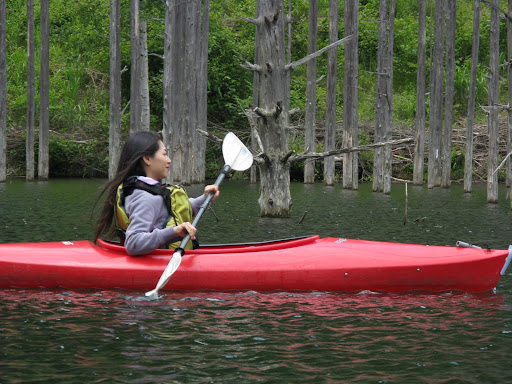 urneys require a return, it's a seed germinated in the departure and required for the end harvest of the whole experience. So, we slid our kayaks once again into the glassy water and headed off down the narrow canyon. The silence of the landscape was disturbed only by our paddles breaking the water's surface, which made sounds that rippled through the air before effervescing into the space around us. Comfortable now in the movements of our kayaks, Aki and I spun ourselves in circles and ran our hands in the cool waters. Overhead clouds mimicked our play, spinning in the blue sky.
urneys require a return, it's a seed germinated in the departure and required for the end harvest of the whole experience. So, we slid our kayaks once again into the glassy water and headed off down the narrow canyon. The silence of the landscape was disturbed only by our paddles breaking the water's surface, which made sounds that rippled through the air before effervescing into the space around us. Comfortable now in the movements of our kayaks, Aki and I spun ourselves in circles and ran our hands in the cool waters. Overhead clouds mimicked our play, spinning in the blue sky.Before heading back to shore I stole a few last moments to take in the scene around me. I watched the swaying of green trees giving shape to unseen winds that swirled down the hillsides. My eyes followed birds that rode these currents of wind: hawks higher up and cormorants lower down near the water's surface. They were all in search of a meal, I guessed, and I wished them luck in their hunts. Finally, I looked back towards the ghostly trees that stick leafless and skeletal straight out of the waters on the western part of the lake, hauntingly beautiful reminders of the earthquake and the birth of Shizen-ko. I took a deep breath, exhaled, and then dug my paddle in deep, heading for shore.
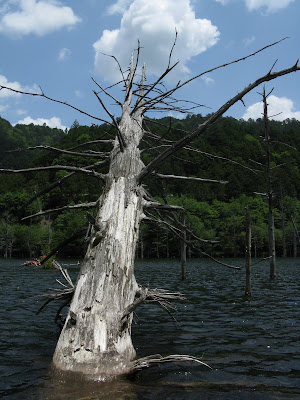 After putting away the kayaks and gear we rendezvoused on the road above Shizen-ko and then walked to the waterfall that N-san had mentioned before. The waterfall was marvelous, but that's a whole other story. Driving back to the village Aki and I hung our arms out the windows of the car and used our flattened palms to surf on the rushing wind. We smiled and talked about what an experience we had just had. Both of us had been surprised at how serene, peaceful, and calming our time on the lake had been. We marveled at the sights we had seen and the detailed knowledge we had gained from our guides. In silence I said a "thank you". To god, perhaps, or the cosmos . . . to life? I'm not sure exactly, but I said "thank you", over and over again.
After putting away the kayaks and gear we rendezvoused on the road above Shizen-ko and then walked to the waterfall that N-san had mentioned before. The waterfall was marvelous, but that's a whole other story. Driving back to the village Aki and I hung our arms out the windows of the car and used our flattened palms to surf on the rushing wind. We smiled and talked about what an experience we had just had. Both of us had been surprised at how serene, peaceful, and calming our time on the lake had been. We marveled at the sights we had seen and the detailed knowledge we had gained from our guides. In silence I said a "thank you". To god, perhaps, or the cosmos . . . to life? I'm not sure exactly, but I said "thank you", over and over again.For details about Shizen-ko and kayak tours please call or visit the website of Ontake Adventure (おんたけアドベンチャー).

0264-48-1208